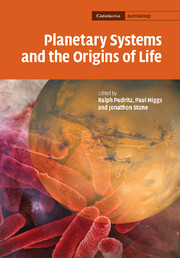Book contents
- Frontmatter
- Contents
- List of contributors
- Preface
- Part I Planetary systems and the origins of life
- 1 Observations of extrasolar planetary systems
- 2 The atmospheres of extrasolar planets
- 3 Terrestrial planet formation
- 4 From protoplanetary disks to prebiotic amino acids and the origin of the genetic code
- 5 Emergent phenomena in biology: the origin of cellular life
- Part II Life on Earth
- Part III Life in the Solar System?
- Index
5 - Emergent phenomena in biology: the origin of cellular life
Published online by Cambridge University Press: 13 August 2009
- Frontmatter
- Contents
- List of contributors
- Preface
- Part I Planetary systems and the origins of life
- 1 Observations of extrasolar planetary systems
- 2 The atmospheres of extrasolar planets
- 3 Terrestrial planet formation
- 4 From protoplanetary disks to prebiotic amino acids and the origin of the genetic code
- 5 Emergent phenomena in biology: the origin of cellular life
- Part II Life on Earth
- Part III Life in the Solar System?
- Index
Summary
Introduction
The main themes of this chapter concern the phenomenon of emergence, the origin of life as a primary example of emergence, and how evolution begins with the inception of cellular life. The physical properties of certain molecular species are relevant to life's origins, because these properties lead to the emergence of more complex structures by self-assembly. One such property is the capacity of amphiphilic molecules such as soap to form membranous boundary structures, familiar examples being soap bubbles and cell membranes. A second example is the chemical bonding that allows biopolymers such as nucleic acids and proteins to assemble into functional sequences. Self-assembly processes can produce complex supramolecular structures with certain properties of the living state. Such structures are able to capture energy available in the environment and initiate primitive reactions associated with metabolism, growth, and replication. At some point approximately 4 billion years ago, cellular compartments appeared that contained macromolecular systems capable of catalysed growth and replication. Because each cellular structure would be slightly different from all others, Darwinian evolution by natural selection could begin, with the primary selective factor being competition for energy and nutrients.
Defining emergence
Researchers increasingly use the term emergence to describe processes by which more complex systems arise from seemingly simpler systems, typically in an unpredictable fashion. This usage is just the opposite of reductionism, the belief that any phenomenon can be explained by understanding the parts of that system.
- Type
- Chapter
- Information
- Planetary Systems and the Origins of Life , pp. 89 - 110Publisher: Cambridge University PressPrint publication year: 2007
- 2
- Cited by



